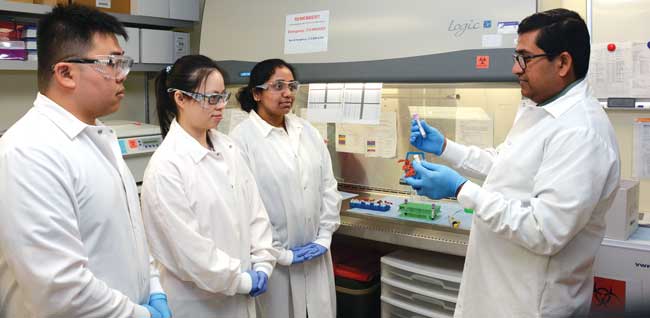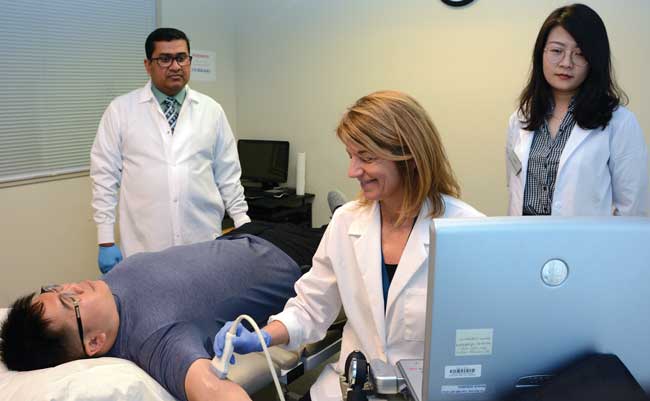The Role of Food in Creating Inner Beauty
INSIDE ACADEMIA

Researchers at the Institute for Food Safety and Health are paying attention to a vital organ that few appreciate.
Many people place great emphasis on their external appearance. For many, questions such as “Does my face have wrinkles?” “Are my pores clogged?” “Is my hair frizzy?” and “Do I look fat in these jeans?” are a daily ritual. But few pay that level of attention to a part of the body that is not readily visible: the cardiovascular system. In the United States, the leading cause of death for men and women is heart disease, and the cost of health care, medications, and lost productivity for cardiovascular disease totals $200 billion per year. Researchers at the Institute for Food Safety and Health (IFSH) at Illinois Institute of Technology (IIT) are working to change those figures, investigating dietary factors that may help maintain the proper functioning of one of the most important organs of the cardiovascular system: the endothelium.
Endothelial Function and Dysfunction
A once underappreciated yet sophisticated vital organ, the endothelium is the membrane lining the inside of the heart and all blood vessels (i.e., arteries, veins, capillaries, and so on). The endothelium has several functions, including controlling exchanges between the blood and tissues, blood clotting, the formation of new blood vessels (angiogenesis), and vascular tone. The vascular tone of blood vessels determines blood pressure; consequently, the endothelium plays a pivotal role in regulating blood flow. The cells that make up the endothelium control the dilation and contraction of blood vessels as blood and nutrients are pumped through the vessels. “[Endothelial cells] produce certain molecules that generate cell relaxation, and that is a way of controlling blood pressure,” says Indika Edirisinghe, an associate professor of food science and nutrition at IFSH and associate director of the Center for Nutrition Research. “If your blood vessels are more rigid, if they cannot dilate, and blood is pumping at a high rate, pressure will increase in the vessels. That pressure directly affects the heart, so then the heart has to work harder.” Therefore, the flexibility of the endothelium is very important for vascular function and heart health. As long as blood vessels remain flexible enough to dilate and contract when blood is pumping, the risk of cardiovascular problems is small. But as the endothelium loses flexibility, a cascade of health problems begin to occur, including high blood pressure, high cholesterol, atherosclerosis, and thrombosis. “If your endothelium is damaged, then it is possible for other molecules to deposit in the vessel, for example, cholesterol. When you have a high cholesterol level, those cholesterol molecules can deposit in the endothelium,” Edirisinghe points out. When cholesterol, fat, blood-clotting proteins, and immune cells accumulate in a damaged endothelium, atherosclerosis occurs.
 Clearly, endothelial dysfunction plays a vital role in the manifestation of cardiovascular disease, so preventing endothelial dysfunction is thus integral in preventing cardiovascular disease. Researchers at IFSH have collaborated with cardiologists and other scientists to determine what causes endothelial dysfunction. “Oxidative stress and inflammation are the two most important factors that can create bad health in the endothelium,” Edirisinghe asserts. Oxidative stress occurs when an excessive amount of reactive oxygen species, or free radicals, are produced in the body. “Those highly reactive compounds can enter the bloodstream and react with some important molecules, such as protein, lipids, and DNA,” Edirisinghe says. “What’s happening is because of the oxidative stress inside the blood vessels, there is inflammation going on. The inflammation is very low-grade, so you don’t feel it as opposed to a fever or common cold, which is acute inflammation.” There are two types of inflammation: acute (or short-term) inflammation and chronic (or low-grade) inflammation. Acute inflammation is an essential immune response to disease, infection, or injury in the body. Chronic inflammation is a persistent low level of inflammation that can damage cells, DNA, and normal organ functions, leading to chronic disease. Chronic inflammation, which creates a highly unfavorable environment inside the blood vessels (and other organs), can go undetected for months or even years.
Clearly, endothelial dysfunction plays a vital role in the manifestation of cardiovascular disease, so preventing endothelial dysfunction is thus integral in preventing cardiovascular disease. Researchers at IFSH have collaborated with cardiologists and other scientists to determine what causes endothelial dysfunction. “Oxidative stress and inflammation are the two most important factors that can create bad health in the endothelium,” Edirisinghe asserts. Oxidative stress occurs when an excessive amount of reactive oxygen species, or free radicals, are produced in the body. “Those highly reactive compounds can enter the bloodstream and react with some important molecules, such as protein, lipids, and DNA,” Edirisinghe says. “What’s happening is because of the oxidative stress inside the blood vessels, there is inflammation going on. The inflammation is very low-grade, so you don’t feel it as opposed to a fever or common cold, which is acute inflammation.” There are two types of inflammation: acute (or short-term) inflammation and chronic (or low-grade) inflammation. Acute inflammation is an essential immune response to disease, infection, or injury in the body. Chronic inflammation is a persistent low level of inflammation that can damage cells, DNA, and normal organ functions, leading to chronic disease. Chronic inflammation, which creates a highly unfavorable environment inside the blood vessels (and other organs), can go undetected for months or even years.
By the time the cumulative effect of chronic inflammation in the endothelium manifests itself, vascular problems are usually too far gone, and the only remedies may be medication and/or surgery. “When you cross to the other side, it’s all medicine,” Edirisinghe says. “But that’s far down; prior to that, there are a lot of things you can do. … As scientists, we have the responsibility to understand and explain to the public that [they] don’t have to go there.” In fact, there are a number of lifestyle modifications that will help prevent endothelial dysfunction and cardiovascular disease, and at the top of the list is diet. “As we study endothelial dysfunction, we’re interested in how the diet can impact its function,” says Britt Burton-Freeman, an associate professor of food science and nutrition at IFSH and director of the Center for Nutrition Research. “A diet that promotes inflammation, a diet that promotes oxidative stress, [or] a person that is obese who has a current physiological status that is proinflammatory would impact the function of the endothelium.”
 Diet, Oxidative Stress, and Inflammation
Diet, Oxidative Stress, and Inflammation
Burton-Freeman, Edirisinghe, and their research teams have been investigating what types of foods can cause endothelial dysfunction via oxidative stress and inflammation and which foods and bioactive compounds can improve endothelial function via antioxidative action. “There are six classes of nutrients: carbohydrate, protein, lipid, water, minerals, and vitamins. These are very important nutrients. We need those nutrients in order to carry out our day-to-day functions. But certain nutrients above the recommended levels will create problems,” Edirisinghe says. This is called diet-induced oxidative stress and inflammation. “We’re understanding the different chemistries of fats and the different chemistries of carbohydrates and how they have an impact. … Certain types of fats and certain types of carbohydrates can promote inflammation, but not everybody is going to have an … inflammatory response to a saturated fat load,” Burton-Freeman adds. “Why that is we don’t completely understand. Similarly, having big spikes in your glucose from carbohydrates can elicit an inflammatory response but not in everybody. So really understanding that variance between people is an important question and something we want to understand more.”
In their quest for greater understanding, the researchers at the Center for Nutrition Research have conducted studies that revealed some interesting information about various foods and how they affect endothelial function. “We have done a lot of research, and we have seen that if you eat a high-carbohydrate, high-fat breakfast (say about 900 calories), your insulin and oxidative stress can go up for like eight hours,” Edirisinghe reveals. This means that measurements of biomarkers for oxidative stress and inflammation after a high-calorie meal are much higher than baseline levels for an extended period of time. To make matters worse, before the body has a chance to recover, many people consume even more food. “Before your stress and inflammation come down, you’re eating your second meal. And then you’re eating again. So the only time you’re letting your body settle is during the nighttime, or the fasting state. Throughout the day, probably 12 to 14 hours, you’re giving a big burden to your body,” Edirisinghe says. “When you have a healthy diet, you don’t put a burden on your body. And if you do put a big burden on your body, then try to add some other compounds to your diet that can help. Those are antioxidant compounds; we also call them anti-inflammatory molecules.” Certain vitamins (C and E), minerals (manganese, selenium, zinc, etc.), and bioactive phytochemicals are antioxidants, and they are most abundant in vegetables and fruits. While all antioxidants are capable of neutralizing excess free radicals, one class of antioxidants stands out in maintaining proper endothelial function: polyphenols.
“We’ve been studying polyphenols and specific types of polyphenols and their effects on endothelial function,” Burton-Freeman says. “What is it about polyphenols that can have a positive effect on endothelial function?” Through a number of studies, Burton-Freeman, Edirisinghe, and their research teams have been able to preliminarily answer that question. Their findings suggest that strawberries, grape seed extract, red raspberries, and blueberries contain polyphenolic compounds that help dilate blood vessels, thereby reducing blood pressure. “Reduction of blood pressure is mostly associated with endothelial function. If you have a healthy endothelium, it causes dilation, and when the vessels dilate, your blood pressure drops,” Edirisinghe asserts. These foods do this by inducing an enzyme (nitric oxide synthase) in the endothelial cells that causes them to generate nitric oxide. “[Their] polyphenols have an impact on the bioavailability of nitric oxide, [which] is a central master molecule to a number of pathways that promote the healthful function of the endothelium,” Burton-Freeman says. Nitric oxide is integral for human health because it maintains the health of blood vessels, lowers blood pressure, and protects against heart attack and stroke; it also regulates gut motility, acts as a neurotransmitter in the brain, and can be effective in the apoptosis of cancer cells. Hence, cardiovascular problems as well as other health problems are linked to nitric-oxide deficiency. “As we age, … there is diminishment of endothelial function; the bioavailability of nitric oxide is part of that equation. So if there is a way that we can enhance or boost nitric oxide through the diet, then that would be beneficial,” Burton-Freeman says. Polyphenols are one way to do that. “I’m a proponent of delivering those through a food because there [are] a number of bioactives that would be delivered with that food and often help to make the most bioactive component more active.”
Managing Appetite and Weight
Much of what the researchers at IFSH are learning about disrupting endothelial dysfunction and cardiovascular disease pertains to appetite regulation and weight management. Overweight and obesity are risk factors for endothelial dysfunction, cardio-vascular disease, and diabetes, so Burton-Freeman and her research team also investigate ways to prevent overeating. “Appetite [regulation] is difficult because of all these mechanisms we have in the environment that promote overriding the signals. That’s probably one of the biggest issues that we deal with today,” Burton-Freeman says. Signals to eat or not eat are generated through the nervous system and the endocrine system, which means appetite regulation is reliant upon the brain, the gut, and various hormones. “When we’re overriding [these signals] and obesity begins to happen, then we have the physiological processes that increase inflammation and oxidative stress, our insulin doesn’t work as well, and then we get insulin resistance,” Burton-Freeman explains. “Essentially, you have a whole milieu that then starts diminishing those signals that would promote appetite regulation.” Making matters worse is the precipitous rise in sedentary lifestyles, which promotes a lack of energy expenditure.
 Food is essential to life, but experts say that most people do not understand how to eat properly, nor do they recognize satiety, which is part of a process that supports appetite regulation. “Food is cheap and extremely refined, so readily available carbohydrates we digest and absorb easily and the same with fat. So the nutrients we actually do take in can be absorbed very quickly: We don’t even have to chew them much; they all kind of melt in your mouth,” Burton-Freeman asserts. “As a society, we eat by the clock; we don’t eat by our hunger cues. It’s noon, and it’s time to take a break. Whether you’re hungry or not is usually immaterial; it’s time to go eat. These are the types of environmental factors that promote obesity.” Besides environmental factors, behavior and genetics also play a role in poor weight management. Because weight management is multifactorial, it may be impossible to find a single solution to cure obesity. “When you think about drug systems, that’s usually a single molecule. There’s no doubt it would probably take a cocktail to really have an impact, hitting several mechanisms that regulate body weight and appetite,” Burton-Freeman says. “I don’t think that the cure for obesity—once we get there—will be one-size-fits-all.”
Food is essential to life, but experts say that most people do not understand how to eat properly, nor do they recognize satiety, which is part of a process that supports appetite regulation. “Food is cheap and extremely refined, so readily available carbohydrates we digest and absorb easily and the same with fat. So the nutrients we actually do take in can be absorbed very quickly: We don’t even have to chew them much; they all kind of melt in your mouth,” Burton-Freeman asserts. “As a society, we eat by the clock; we don’t eat by our hunger cues. It’s noon, and it’s time to take a break. Whether you’re hungry or not is usually immaterial; it’s time to go eat. These are the types of environmental factors that promote obesity.” Besides environmental factors, behavior and genetics also play a role in poor weight management. Because weight management is multifactorial, it may be impossible to find a single solution to cure obesity. “When you think about drug systems, that’s usually a single molecule. There’s no doubt it would probably take a cocktail to really have an impact, hitting several mechanisms that regulate body weight and appetite,” Burton-Freeman says. “I don’t think that the cure for obesity—once we get there—will be one-size-fits-all.”
There are things that can help people avoid the primary factors that lead to endothelial dysfunction, cardiovascular disease, obesity, and other metabolic problems. “The risk factors are your diet—not following a healthy diet pattern. The second thing is exercise—your physical activity level,” Edirisinghe says. “Then your stress level and your family history. Even though we know that family history plays a significant role, even family histories can be modulated with dietary factors.” So for many, lowering the risk of cardiovascular and metabolic disease may be as simple as consuming a balanced diet that includes plant foods and engaging in physical activity. “There’s a lot of discussion about fiber’s role in body-weight regulation. … Certainly, fiber has its role in cholesterol and glucose metabolism. Fiber has a role in regularity and colon health,” Burton-Freeman says. “This is an area that we have spent some time on. We’ve also been working quite a bit on polyphenols, so nonnutritive bioactive components of foods might have yet another role in metabolic regulation.”
 Endothelial dysfunction and cardiovascular disease are just two of the areas being investigated at the Center for Nutrition Research, which is one of four centers at IFSH. The research institute was founded to provide a platform for IIT researchers, the U.S. Food and Drug Administration, and the food industry to work together to find solutions to food safety, food defense, nutrition, and health issues affecting consumers. Approximately 70 industry partners work with IFSH, including large food companies such as Conagra, PepsiCo, Coca-Cola, and Nestlé as well as midsize and small companies. “The Institute for Food Safety and Health was founded some 30 years ago,” Edirisinghe says. “It is a unique platform that combines industry, academia, and government together. If you look at the issues related to chronic diseases (diabetes, heart disease, cancer), a single entity cannot handle this. You need a collaboration, and the best collaborative model is government, industry, and academia.” All of the centers of IFSH work collaboratively to ensure that a new product is not only safe but also nutritious. “The Center for Nutrition Research started when we became the Institute for Food Safety and Health; we became a center under that umbrella,” Burton-Freeman adds. There are many research projects on the horizon for the Center for Nutrition Research. These projects include exploring how dietary factors can modulate cognitive function as well as endothelial function and cardiovascular function. In fact, recent research performed at the center indicates that the consumption of blueberries, which are rich in anthocyanins, helps improve cognitive function. The center is also investigating the relationship between diet, gut microbes, and vascular function.
Endothelial dysfunction and cardiovascular disease are just two of the areas being investigated at the Center for Nutrition Research, which is one of four centers at IFSH. The research institute was founded to provide a platform for IIT researchers, the U.S. Food and Drug Administration, and the food industry to work together to find solutions to food safety, food defense, nutrition, and health issues affecting consumers. Approximately 70 industry partners work with IFSH, including large food companies such as Conagra, PepsiCo, Coca-Cola, and Nestlé as well as midsize and small companies. “The Institute for Food Safety and Health was founded some 30 years ago,” Edirisinghe says. “It is a unique platform that combines industry, academia, and government together. If you look at the issues related to chronic diseases (diabetes, heart disease, cancer), a single entity cannot handle this. You need a collaboration, and the best collaborative model is government, industry, and academia.” All of the centers of IFSH work collaboratively to ensure that a new product is not only safe but also nutritious. “The Center for Nutrition Research started when we became the Institute for Food Safety and Health; we became a center under that umbrella,” Burton-Freeman adds. There are many research projects on the horizon for the Center for Nutrition Research. These projects include exploring how dietary factors can modulate cognitive function as well as endothelial function and cardiovascular function. In fact, recent research performed at the center indicates that the consumption of blueberries, which are rich in anthocyanins, helps improve cognitive function. The center is also investigating the relationship between diet, gut microbes, and vascular function.


